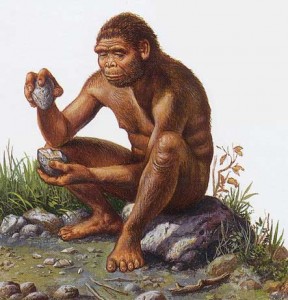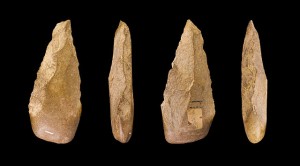In thinking about the 2.6 million year history of stone tools, we often discus the ways in which hands shaped stone; but how did the tools they made shape the hands we use today?
Not surprisingly, the ability to make stone tools had a huge effect on the anatomy of the human hand. Individuals whose hands were better suited to making tools were better able to hunt and protect themselves; this made them more evolutionarily fit (able to produce more offspring), leading to an eventual proliferation of the genes involved in the better hand formation. So when stone tools went from simple banged rocks to complex hand-axes around 1.7 million years ago, this reflected not only an intellectual step but a biological one.
Before this new technology, the fossil record shows that hominin hands had primitive vestige structures. Although Homo habilis (named the “toolmaker” because of the primitive Oldowan tools found in associated strata) had more advanced hands than those of their predecessors the australopithecines, they were not fully modern. Their fingers had a gentle curve like those of the austrolopithicines, and their wrist morphology resembled that of a part-time arboreal species. Despite these primitive traits, the more modern proportions and joint connecting the finger bones to those of the palm allowed Homo habilis to be credited with the invention of stone tools.
For a long time, the hand’s evolution from 1.7 million years ago (when Homo erectus first shows up in the fossil record and shortly before Homo habilis disappears from it 1.4 million years ago) to about 800,000 years ago was a mystery to paleoanthropologists. Hominin fossils are a rare find at best, and small finger bones especially are easily broken in the millennia they spend in the soil before being excavated. Stone tools, on the other hand, are much more easily preserved. During this almost 1 million year gap, stone tool technology advanced greatly, enough to warrant a new name – Acheulean industry. But what morphological difference had made this advancement possible?
A recent discovery has shed some light on this question. In 2010, a team of paleoanthropologists led by Fredrick Kyalo Manthi of the National Museums of Kenya found what appeared to be a finger bone in northern Kenya. It was identified as a third metacarpal, the bone that connects the middle finger to the wrist. Using isotope analysis, it was dated to 1.4 million years ago and attributed to the species Homo erectus. What’s interesting about this bone is the small bump at its base – the styloid – a feature found in modern humans. What seems like a small structural change has huge implications; the styloid helps stabilize the wrist, increasing griping power between the thumb and forefinger. This change was instrumental in the ability to make finer, more precise percussions to the core, resulting in more fine-tuned tools with which Homo erectus became the first multi-continental hominin. None of this would have been possible without the mutual selective pressure between early humanity and its tools.
Sources:
Reardon, Sara. “Stone tools helped shape human hands.” New Scientist, 11 April 2013. http://www.newscientist.com/article/mg21829124.200-stone-tools-helped-shape-human-hands.html#.Um1JMpE7ZuZ
University of Kent. “Stone tools influenced hand evolution in human ancestors, anthropologists say.” ScienceDaily, 8 Mar. 2011. http://www.sciencedaily.com/releases/2011/03/110307101504.htm
Homo habilis image URL: http://earlyman.yolasite.com/resources/homo%20habilis%203.jpg
Hand ax image URL: http://upload.wikimedia.org/wikipedia/commons/thumb/8/87/Biface_Cintegabelle_MHNT_PRE_2009.0.201.1_V2.jpg/640px-Biface_Cintegabelle_MHNT_PRE_2009.0.201.1_V2.jpg




